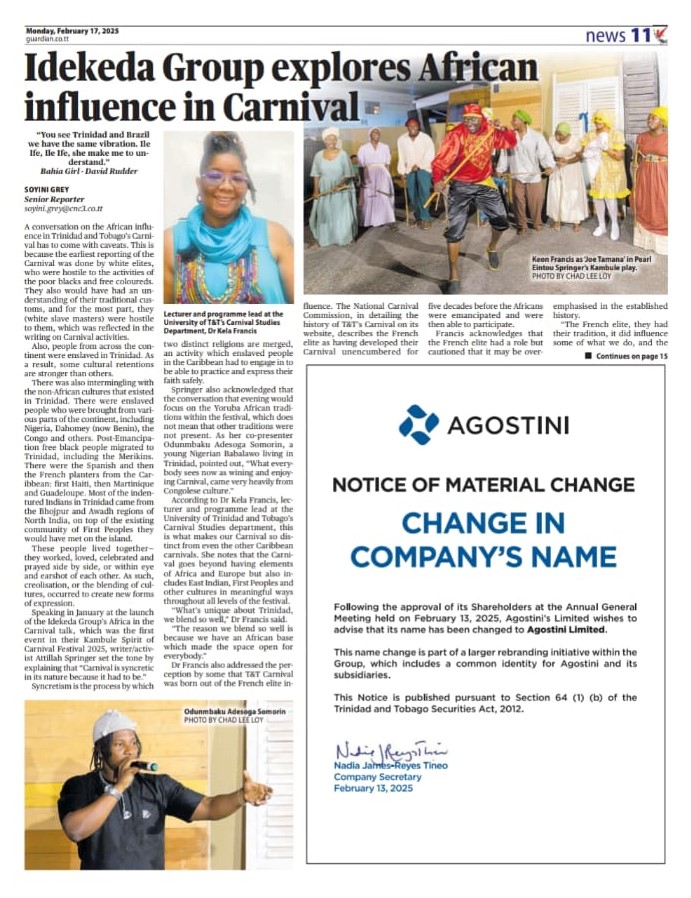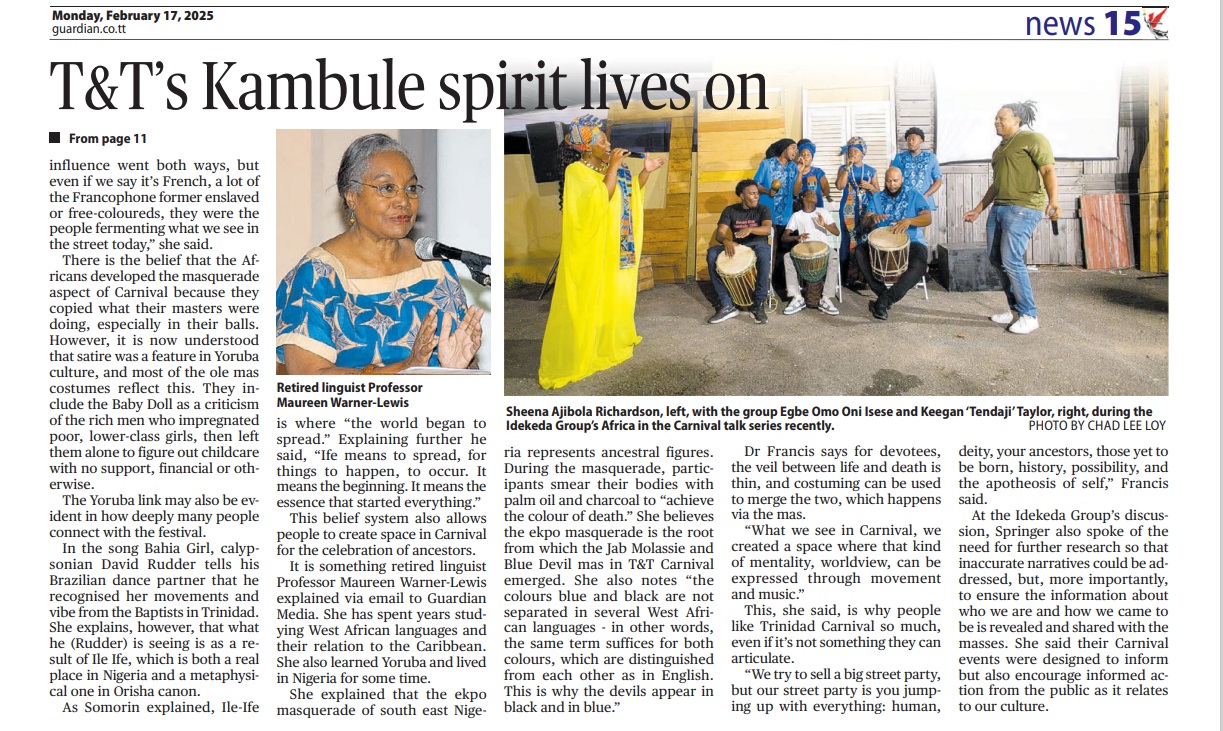Africa In The Carnival

“You see Trinidad and Brazil we have the same vibration. Ile Ife, Ile Ife, she make me to understand.”
Bahia Girl – David Rudder
A conversation on Africa in the Carnival has to come with caveats. The earliest reporting of the Carnival was done by White elites who were hostile to the activities of the poor blacks and free coloureds. They also would have had little understanding of their traditional customs, and for the most part, they (white slave masters) were hostile to them, which is reflected in the writing.
Also, people from across the continent were enslaved in Trinidad. As a result, some retentions are stronger than others.
There was also intermingling with the non-African cultures that existed in Trinidad. There was enslaved people who were brought from various parts of the continent including Nigeria, Dahomey (now Benin), the Congo and others. Post-Emancipation free black people migrated to Trinidad including the Merikins. There was the Spanish and then the French planters from the Caribbean: first Haiti, then Martinique and Guadeloupe. Most of the Indentured Indians in Trinidad came from the Bhojpur and Awadh regions of North India on top of the existing community of First Peoples they would have met on the island.
These people lived together. Work, love, celebrate and pray side by side, or within eyeshot, as such, creolisation, or the blending of cultures, occurred to create new forms of expression.
Speaking in January at the launch of the Idakeda Group’s Africa in the Carnival talk, which is the first event in their Kambule Spirit of Carnival Festival 2025, writer/ activist Attillah Springer set the tone by explaining that “Carnival is syncretic in its nature because it had to be.”
Syncretism is the process by which two distinct religions are merged, which enslaved people in the Caribbean engaged in to be able to practice and express their faith safely.
Springer also acknowledged that the conversation that evening would focus on the Yoruba African traditions within the festival, which does not mean that other traditions were not present. As her co-presenter Odunmbaku Adesoga Somorin, a young Nigerian Babalawo living in Trinidad, pointed out, “What everybody sees now as wining and enjoying Carnival, came very heavily from Congolese culture.”
According to Dr Kela Francis, lecturer and programme lead at the University of Trinidad and Tobago’s Carnival studies department, this is what makes our Carnival so distinct from even the other Caribbean carnivals. She notes that the Carnival goes beyond having elements of Africa and Europe but also includes East Indian, First Peoples and other cultures in meaningful ways throughout all levels of the festival.
“What’s unique about Trinidad, we blend so well,” Dr Francis said. “The reason we blend so well is because we have an African base which made the space open for everybody.”
Dr Francis also addressed the perception by some that our Carnival was born out of the French elite influence. The National Carnival Commission, in detailing the history of Trinidad’s Carnival on its website, describes the French elite as having developed their Carnival unencumbered for five decades before the Africans were emancipated and were then able to participate.
Francis acknowledges that the French elite had a role but cautioned that it may be overemphasised in the established history.
“The French elite, they had their tradition, it did influence some of what we do, and the influence went both ways, but even if we say it’s French, a lot of the Francophone former enslaved or free-coloureds, they were the people fermenting what we see in the street today,” she said.
There is the belief that the Africans were introduced to masquerade because they wanted to copy what their masters were doing, especially in their balls. However, it is now understood that satire was a feature in Yoruba culture, and most of the old mas costumes reflect that. They include the Baby Doll as a criticism of the rich men who impregnated poor, lower-class girls leaving them alone to figure out childcare with no support, financial or otherwise.
The Yoruba link may also be evident in how deeply many people connect with the festival.
In the song Bahia Girl, David Rudder tells his Brazilian dance partner that he recognised her movements and vibe from the Baptists in Trinidad. She explains that what he is seeing is as a result of Ile Ife, which is both a real place in Nigeria and a metaphysical one in Orisha canon. As Somorin explained, Ile-Ife is where “the world began to spread.” Explaining further he said, “Ife means to spread, for things to happen, to occur. It means the beginning. It means the essence that started everything.”
This belief system also allows people to create space in Carnival for the celebration of ancestors.
It is something retired linguist Professor Maureen Warner-Lewis explained via email to Guardian Media. She has spent years studying West African languages and their relation to the Caribbean. She also learned Yoruba and lived in Nigeria for some time.
She explained that the ekpo masquerade of south east Nigeria represents ancestral figures. During the masquerade, participants smear their bodies with palm oil and charcoal to “achieve the colour of death.” She believes the ekpo masquerade is the root from which the jab molassie and blue devils in T&T Carnival emerged. She also notes “the colours blue and black are not separated in several West African languages – in other words, the same term suffices for both colours, which are distinguished from each other as in English. This is why the devils appear in black and in blue.”
Dr Francis says for devotees, the veil between life and death is thin, and costuming can be used to merge the two, which happens via the mas.
“What we see in Carnival, we created a space where that kind of mentality, worldview can be expressed through movement and music.”
This, she said, is why people like Trinidad Carnival so much, even if it’s not something they could articulate.
“We try to sell a big street party, but our street party is you jumping up with everything: human, deity, your ancestors, those yet to be born, history, possibility, and the apotheosis of self,” Francis said.
At Idakeda’s discussion, Springer spoke of the need for further research for inaccurate narratives to be addressed, but more importantly to ensure the information about who we are and how we came to be is revealed and shared with the masses. She said their Carnival events were designed to inform but also to encourage informed action from the public as it relates to their culture.
